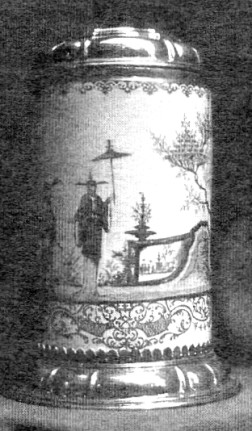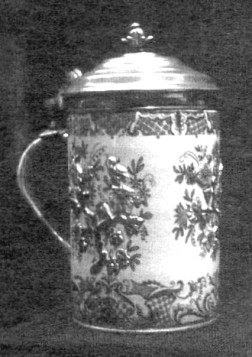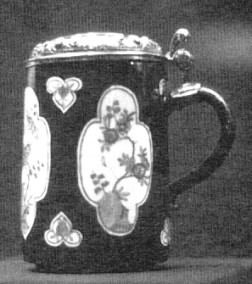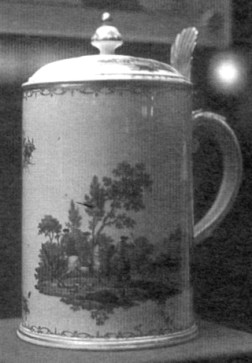|
|
||||||||
|
|
||||||||
|
This is the last of three articles
which appeared in Prosit from Dec. 1990 to June 1991.
|
||||||||
|
Part 3. German Porcelain Steins of the 18th Century: Vienna and Ludwigsburg In concluding this series about the Gardiner Collection in Toronto, we have to write about two major factories, the one in Vienna, the other in Ludwigsburg. Their story will be told in the context of their wares being represented in the permanent exhibits of the Canadian museum. Vienna, Du Paquier (1718-1744) or, respectively, the Imperial and Royal Aerial Porcelain Factory (1744-1864) The secret of making porcelain was not preserved at Meissen for any length of time! The Royal Vienna factory was the second one in Europe to obtain that secret: It was brought there by intrigue and the enticement of Meissen workers. When the Turkish threat to Vienna was eliminated at the beginning of the 18th century, a new artistic development spread through the city. The focus was not only on the traditional fields such as architecture, sculpture and painting, but also on that wonderful new material, porcelain. It is told that Claudius Innocentius Du Paquier (ref. 4), an imperial and royal war-agent, was able to establish the factory in 1718 with the help of two deserters from Meissen. Du Paquier's first attempts at producing a porcelain-like material date from 1716, but those were unsuccessful. In 1717 he hired Christoph Conrad Hunger (ref. 5) from Meissen. Hunger claimed he was privy to the secret: Boettger, while drunk, had supposedly told him the details of how to make porcelain. With the help of Mr. Hunger's knowledge of porcelain production, Du Paquier succeeded in making several samples of real hard-paste porcelain in 1718. After that, Emperor Karl VI, by means of an official privilege dated May 27, 1718, permitted Du Paquier for a 25-year period to produce "porcelain majolica and Indian tablewares, vessels and pots, such as made in East India and other foreign lands" (ref 6). The second worker from Meissen was the kiln specialist Samuel Stölzel, who fled to Vienna in 1719 - although he was considered to be one of the best workers at the Meissen factory.
The loss of these efficient (and knowledgeable) workers was the first reason for Du Paquier's upcoming problems; the second reason was his almost permanent poor financial situation. Production repeatedly stagnated in the following years. Since the emperor's privilege was valid only until 1744, Du Paquier sold the factory to the state, rather than renewing the privilege for his monopoly. It thus became the Imperial and Royal Aerial Porcelain Factory. Despite many change, difficulties continued to plague the factory, and it was finally decided to close it in 1864. Items made at the Vienna factory were known to be very expensive - even in 1730. But the quality and variety of Du Paquier's porcelain must have been remarkable. Although the items produced in the first few years obviously showed the Meissen influence because of Stölzel, Vienna was soon able to find its own artistic "language." Most of the early Vienna production is not marked, but can be identified as Vienna porcelain because of the specific characteristics of bodies and glazes, as well as the unmistakable Du Paquier ornamentation: Borders in English red, or ornamental foliage and lattice work, known as "Bandelwerk." The tableware sets, as well as the outstandingly beautiful one-of-a-kind pieces, derived their shapes from Eastern as well as Meissen porcelain designs. Other inspirational sources were the ornate designs used to shape and decorate precious metals. Since there were so many different shapes, a large variety of patterns existed: The figurative scenes show Chinese motifs (fig. 12), cherubs, hunting and war scenes, as well as mythological and allegorical representations. The painting was done in either one color (monochrome) or in polychrome (figs. 13 and 14). It is certain that a blue under-glaze was used starting in 1772. The works of painters and modelers remained mostly anonymous until 1744. An exception is the Vienna stein shown in fig. 12: We know that the artist's name was Joseph Philipp Dannhöfer (or Danhöfer). He was born in Vienna in 1712 and started his career as a painter in Vienna. In 1737 he left for the Bayreuth faience factory, and in 1749 he can be identified as being a painter of bright colors at the porcelain factory in Höchst, near Frankfurt on the Main (ref. 8). From 1762 to 1790 he did the same type of work at the Ludwigsburg factory in Württemberg (ref. 9), where the last stein we will comment on was made. Ludwigsburg, "Herzoglich Aechte Porcelain Fabrique" (1758-1806) and the Royal Porcelain Factory (1806-1824) The mid-18th century collecting fever and the liking for things of beauty also arose in Württemberg, where Duke Carl Eugen resided and reigned. Carl Eugen had been at the court of Frederick the Great in Berlin for two years, and after his return home he wanted to enjoy the same French-inspired luxury he had experienced in Berlin. He succeeded after a very short while and his court was known as the most magnificent and merry one in Germany. A duke with such a reputation had to have his own porcelain factory! Therefore, by the decree of April 5, 1758, he ordered the founding of a porcelain factory in Ludwigsburg, near Stuttgart. The first attempts to learn the secret of porcelain were negative, until the painter and porcelain initiate Joseph Jacob Ringler (ref. 10) came to Ludwigsburg in February 1759. He had gained a lot of experience at Höchst, Strassburg and other smaller factories, and was thus able to get into production quite fast. Ringler was to be the factory director for more than 40 years. A few months after he arrived in Ludwigsburg he was able to attract many workers from other German faience and porcelain factories: We know of Gottlieb Friedrich Riedel (ref. 11), an artist and designer who had worked at Meissen (1743-1756), in Höchst and at Frankenthal (ref. 12) from 1757 to 1759 as a painter of animals and birds. Other known artists were J. F. Steinkopf and A. P. Oettner. The modeler and sculptor J. Chr. W. Beyer, who had studied in Paris and Rome, worked at the factory from 1759 to 1767. During this period the figurines and statuettes show a tendency towards the classical: This elegant Louis XVI style was adopted for vessels starting in 1780. The artist Joseph Philipp Dannhöfer (mentioned earlier as the designer of the Viennese stein in fig. 14) was lured from Höchst to Ludwigsburg in 1762; however his designs for the Württemberg porcelain factory have not yet been identified. Over 100 workers were busy in Ludwigsburg in 1760, and only six years later there were more than 150. This made it possible for the factory to develop its "golden season" during the first decade of its existence. It was during this period that the stein shown in fig. 15 was made. The economic success of the factory ended suddenly after this short period of ten years, and therefore Duke Carl Eugen had to support the factory with his own purse from 1770 on. After his death in 1793 this financial support stopped and the decline of the factory began and its very existence was endangered. The successor, Duke Frederic II, tried to reorganize the factory by paying off all debts. After his election as King Frederic I of Württemberg in 1805, the factory was renamed the Royal Porcelain Factory. When the king died in 1816, the factory's decline started again because Frederic's successor, William I, was not interested in keeping or supporting the expensive and poorly operating factory. The factory was finally closed in 1824. Until the beginning of the 19th century, Ludwigsburg porcelain did not have the white color, the purity and the brilliance we see in porcelain from other German factories. The reason was to be found in the white clay from Passau and the kaolin from Hornberg; these materials produced a gray colored, often even brownish, but very plastic, porcelain. Since Duke Carl Eugen preferred figural centerpieces, most of the items from Ludwigsburg had a sculptured character, and the porcelain was very well suited for this type of product. Since shaped and modeled pieces have been in use for decades, this information does not help us in precisely dating these items. Riedel not only developed forms and relief ornaments, but also painted patterns. His favorite motifs were birds and insect; we rarely find flowers or landscapes from him. Johann Friedrich Steinkopf (ref. 13), the artist who made the stein shown in fig. 15, preferred landscapes and horses. He can be called the ancestor of the Württemberg artist family Steinkopf. He was an enamel painter at the Palatine porcelain factory in Frankenthal before he came to Ludwigsburg. His employment papers are dated from November 15, 1759, and emphasize his responsibility to paint animal and landscape patterns. When the first financial problems of the factory started around 1776, he left Ludwigsburg to go to Stuttgart, where he painted only in oils. Learning from nature and from the old masters, he published a series of etchings in 1777, showing his favorite motif: Groups of horses. He began teaching art at a secondary school in Stuttgart in 1782.
This very elegant stein is an exception to the eleven steins we have described previously: On the one hand because there is much free space on the body, bordered only by very elegant golden ornaments comparable to a rococo painting; on the other hand because of the ceramic lid with its artistic button-shaped finial and profile; the hinge is the only metal part on the stein. This stein serves as a very special end to our tour through the Gardiner Museum of Ceramic Art in Toronto. All that remains now is for me to recommend to our readers a visit to this wonderful Museum if you travel to Toronto - it is remarkable and worthwhile! References (reference are numbered sequentially through all three articles):
|
Continue your reading by following either of these links:
 ~The George R.
Gardiner Museum of Ceramic Art~
~The George R.
Gardiner Museum of Ceramic Art~


